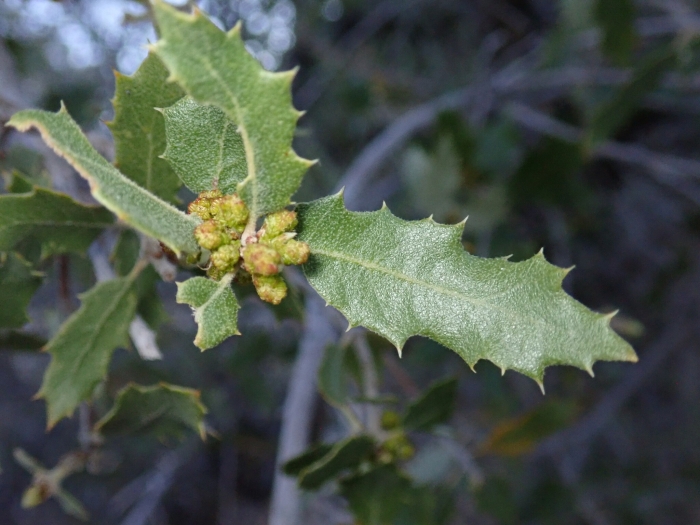Muller Oak
(Quercus cornelius-mulleri)
Muller Oak (Quercus cornelius-mulleri)
/
/

Cricket Raspet
CC BY 4.0
Image By:
Cricket Raspet
Recorded By:
Copyright:
CC BY 4.0
Copyright Notice:
Photo by: Cricket Raspet | License Type: CC BY 4.0 | License URL: http://creativecommons.org/licenses/by/4.0/ | Rights Holder: Cricket Raspet | Publisher: iNaturalist | Date Created: 2024-04-14T23:03:52-07:00 |

























Estimated Native Range
Summary
Quercus cornelius-mulleri, commonly known as Muller Oak, is an evergreen shrub native to the chaparral and oak woodlands of southern California and Baja California, particularly thriving in the foothills and mountains. It is a compact, bushy shrub that typically does not exceed 10 feet in height, with densely branched twigs that contribute to its full appearance. The leaves of Muller Oak are evergreen, leathery, and thick, with a notable bicolored aspect that adds to its visual interest. The acorns are distinctive, featuring a cap up to 0.75 inches wide that is covered in light-colored scales, and a cylindrical nut with a rounded end, measuring up to 1.25 inches long.
Muller Oak is appreciated for its drought tolerance and ability to thrive in the challenging conditions of its native chaparral habitat. It is often used in xeriscaping, naturalistic plantings, and as a component of wildlife gardens, where its acorns provide food for local fauna. In cultivation, it requires minimal maintenance, making it a suitable choice for gardeners seeking low-water-use plants. It prefers full sun to partial shade and is adaptable to a variety of well-drained soils. While it is not commonly afflicted by serious diseases or pests, gardeners should be aware of oak root fungus (Armillaria mellea), which can be problematic in poorly drained soils.CC BY-SA 4.0
Muller Oak is appreciated for its drought tolerance and ability to thrive in the challenging conditions of its native chaparral habitat. It is often used in xeriscaping, naturalistic plantings, and as a component of wildlife gardens, where its acorns provide food for local fauna. In cultivation, it requires minimal maintenance, making it a suitable choice for gardeners seeking low-water-use plants. It prefers full sun to partial shade and is adaptable to a variety of well-drained soils. While it is not commonly afflicted by serious diseases or pests, gardeners should be aware of oak root fungus (Armillaria mellea), which can be problematic in poorly drained soils.CC BY-SA 4.0
Plant Description
- Plant Type: Tree
- Height: 6-15 feet
- Width: 6-15 feet
- Growth Rate: Moderate
- Flower Color: N/A
- Flowering Season: Spring, Winter
- Leaf Retention: Evergreen
Growth Requirements
- Sun: Full Sun, Part Shade
- Water: Low
- Drainage: Medium, Fast
Common Uses
Drought Tolerant, Erosion Control, Low Maintenance
Natural Habitat
Native to the chaparral and oak woodlands of southern California and Baja California, particularly in foothills and mountains
Other Names
Common Names: Muller’s Oak, Desert Scrub Oak, Cornelius Muller Oak
Scientific Names: , Quercus cornelius-mulleri,
GBIF Accepted Name: